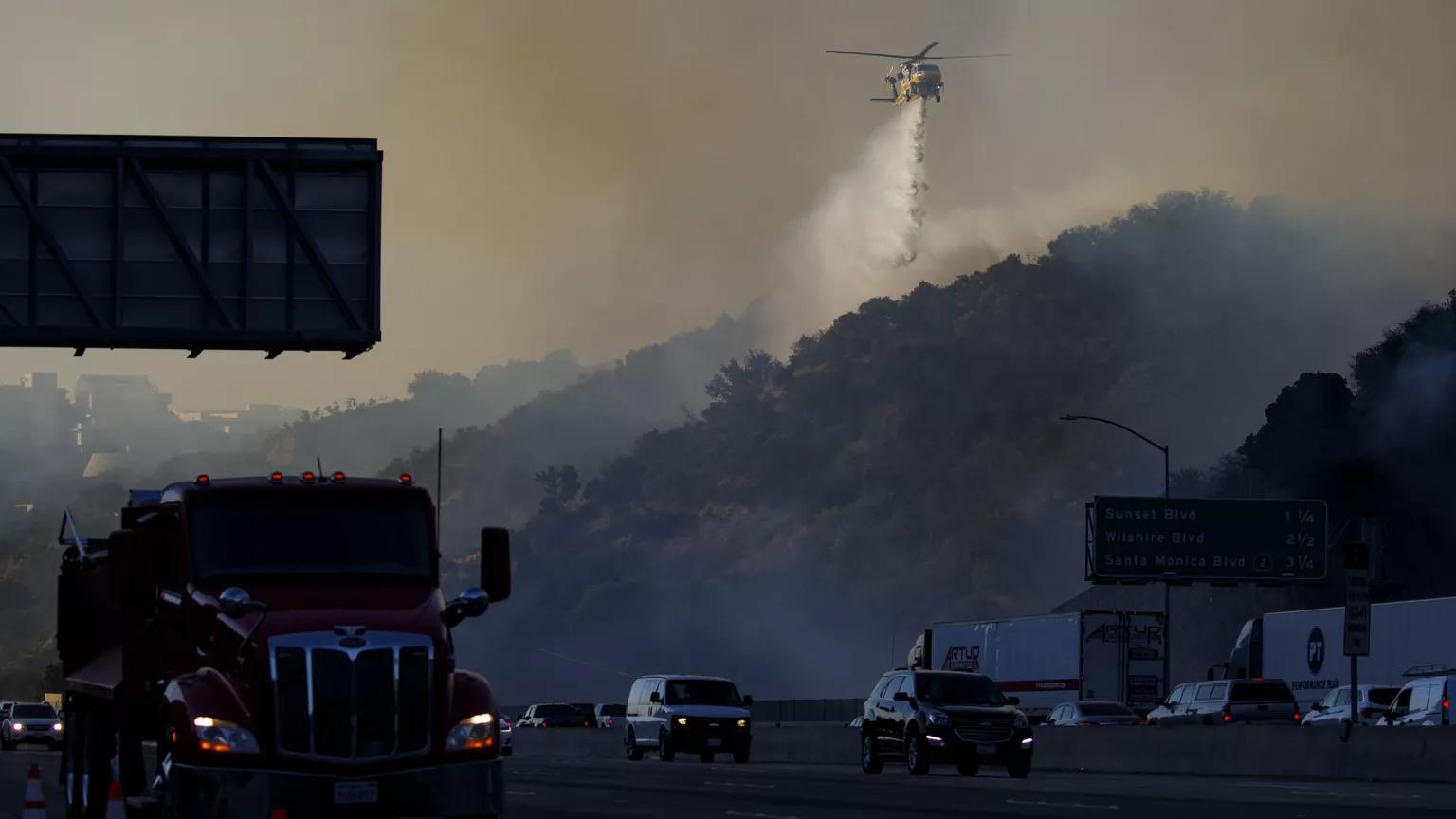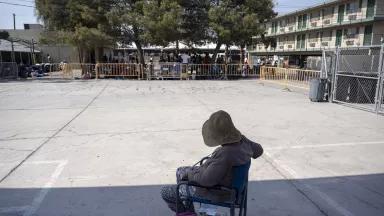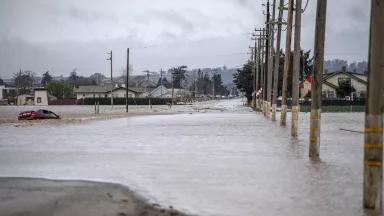How to Make a Wildfire Evacuation Plan
Fires can be wild and unpredictable—don’t let your reaction to them be the same.

Los Angeles orders evacuations as the Getty Fire spread west in October 2019 in California.
Patrick T. Fallon/Bloomberg via Getty Images
The 2024 U.S. wildfire season is already off to a scary start. The total acreage burned to date is 133 percent above the national 10-year average. And climate scientists expect higher-than-normal temperatures to persist through October.
Many communities are still reeling from wildfires in 2023—like the one that swept through Maui in August, killing 101 people, injuring dozens more, and causing $5.5 billion in damages. The effects of the record fire season on Canada, where nearly 46 million acres of land burned, also triggered unprecedented public health emergencies across much of the United States.
Peak wildfire season varies slightly by region, but wildfire activity generally picks up in the summer months between April and October. Still, as climate change intensifies, some areas could see earlier springs, hotter summers, and drier vegetation. In turn, we could be dealing with longer fire seasons and more severe blazes that spread faster and are harder to put out. This picture is further complicated by the intensification of forest extraction, urban development in wildlands, the active suppression of all fires (including those that reduce fuel buildup), and the loss of forest stewardship as Indigenous Peoples are displaced.
With these increasing risks in mind, knowing what to do in case you ever encounter a wildfire is critical. Here are some preparation and evacuation tips; also be sure to read up on how to stay safe from wildfire smoke.
Preparation
Sign up for alerts
Stay informed on weather events, especially if you are in a fire-prone area.
Most wireless providers participate in a free public safety system run by the Federal Emergency Management Agency (FEMA) that alerts people to public safety issues or imminent threats in their area. You may need to turn this feature on in your cell phone’s settings in order to receive the messages.
For iPhones: Go to Settings→Notifications. Scroll down to the Government Alerts section and toggle on the alerts you want to get.
For Androids: Go to Settings→Safety and Emergency→Wireless Emergency Alerts. Toggle on the alerts you want to get.
FEMA also has an app that will send real-time weather alerts, tips on preparing for extreme weather, and information on locating emergency shelters. Wildfire tracking apps can also be helpful if you live in a particularly risky area. Watch Duty, Fires—Wildfire Info & Atlas, and Firesource are free options with tracking features.
If you don’t have a smartphone, you can likely stay connected to your city's emergency announcement system in other ways. For example, residents of Los Angeles, Seattle, and Dallas can receive alerts through email, text, or landline calls.
Make an escape plan
Take some time to put together an evacuation plan and share it with your family. Here are some important considerations:
- Do you have a place to stay for a few days?
- Is there a friend’s or family’s house in another city or state that you can go to? If not, look up the closest recommended emergency shelter via the Red Cross. You can also text SHELTER and your zip code to 43362. Note: Many shelters or hotels do not allow pets, so seek out accommodations where your animal companions can take cover too.
- Do you have transportation?
- If you don’t have a car or cannot drive, reach out to your friends, family, or neighbors to coordinate carpooling. Alternatively, contact local emergency services to learn about transportation options ahead of time. Be sure to map out two different evacuation routes as one route may become impassable due to the fires.
- Do you have loved ones who would require extra help during an emergency evacuation?
- If you or any family members have serious health issues, speak with a doctor to prepare an emergency medical plan.
- Carry the contact information of nearby family or friends who may need assistance.
- Become familiar with local emergency protocols and services in your area, including fire departments, faith-based organizations, and community centers.
Pack a go bag
Gathering necessary supplies beforehand makes it easier to evacuate on the fly. For wildfires, a stash of face masks, preferably N95s, is a go bag must-have. It’s a good idea to have an extra bag with essentials stashed in your car as well, in case you’re out and don’t have time to go home. Ready.gov has an extensive list of items you should bring, but here are the basics:
- Three days’ worth of drinking water (a gallon per person per day) and/or a water filter
- Three days’ worth of nonperishable food (plus pet food, if necessary)
- Medications
- Toiletries
- Extra clothes and layers
- First aid kit
- Portable radio
- Extra batteries
- Emergency blanket
- Flashlights, LED lights, or light sticks
- Face mask (N95 is preferred)
- Cash, in case ATMs are not available
- Identification and insurance cards
- Paper maps of the area
Store your valuables and documents
Make digital copies of important documents to store electronically. If you’re in a fire-prone area, think about opening up a safety deposit box at your local bank to keep the originals and other valuable items safe. You can also buy a fireproof and waterproof safe to keep in your house—although sustained fire or heat exposure can still damage contents inside.
Set up your cell phone’s emergency settings
Make use of features on your phone designed to aid in an emergency. Depending on the model, you can set up Health or Personal Safety apps with your medical information, emergency contacts, and other critical details. First responders can access this info right from your lock screen.
During a wildfire
Pay attention to the news
The rule of thumb when it comes to wildfires is to leave when you can. Pay attention to emergency announcements through your cell phone or battery-powered radio and avoid making last-minute decisions on whether to ride it out in your home or take a chance in your car. When authorities issue evacuation orders, go. Wildfires can hopscotch across the landscape, blocking escape routes suddenly, so it’s best to leave well ahead of time.
Prepare to evacuate
- If you have plenty of time before a fire reaches your home, move any particularly flammable materials (curtains, doormats, etc.) to the middle of the room and turn off your gas line. Outside, move any fire pits or outdoor grills with propane tanks at least 10 feet away from your home and clear the area around it from anything combustible. This can help minimize the damage to your home. (And there’s no need to wait for an emergency to take these additional measures to make your property firesafe.)
- If you plan on driving, fill up on gasoline or electricity on the early side to avoid delays. Check the news for any road closures.
- If you will not be driving, follow evacuation instructions from public safety officials. Reach out to local services to get updates on transportation options or arrange a carpool.
When you cannot evacuate
Sometimes there isn’t enough time to evacuate. If you are in immediate danger, call 911 and follow these tips if emergency services cannot promptly come to rescue you.
If a wildfire comes near your home:
Designate a “clean room” in your house, one with the fewest number of windows, and take these steps to minimize smoke exposure.
- Close all doors and windows.
- Set the air conditioner to recirculate so it stops taking in outside air.
- Turn on all indoor and outdoor lights, if necessary, so firefighters can locate you more easily through the smoke.
- Fill sinks and tubs with cold water.
- Avoid cooking, smoking, or burning candles.
- Turn on a portable air filter if you have one.
Even if you are a safe distance from the flames of a wildfire, dangerous smoke can still reach you. Keep an eye on the Air Quality Index and take the same precautions listed above if the particulate pollution reaches unhealthy levels. This is especially crucial if you or a family member has respiratory issues or is in a high-risk category.
If a wildfire reaches you in the car:
Being in a vehicle during a wildfire is dangerous, but it’s still better than being outside. Turn the car around if you see smoke and be aware of fallen trees and poles. If your vehicle is damaged and can no longer be driven, do NOT leave the vehicle to try to outrun the fire. Wildfire can travel as fast as 14 miles an hour, nearly twice the running speed of the average human.
- Park behind a solid structure, like a building or wall, to avoid as much heat as possible. If there isn’t anything nearby, park in an open area without any combustible materials like grass or trees.
- Leave your car running, roll up the windows, close all air vents, and set your AC to recirculate.
- Keep your hazard lights and regular lights on to increase visibility of your car and to help emergency services locate you more easily.
- Get as low as possible on the floor of the car.
- Cover yourself with a wool blanket if you have one.
- Wet a piece of cloth and lay it on your face to make it easier to breathe.
If a wildfire reaches you outside on foot:
The worst-case scenario is if you are caught outside on foot during a wildfire. If you can, get to the nearest building or shelter of any sort to avoid the worst of the fire. If there is nothing around you, move to a clear area without any vegetation, lie face down, cover your body with a blanket or jacket, and call 911.
If you’re considering sheltering in water:
Taking refuge in a pool or any other body of water might seem like a good idea, but it should be your last resort. Being in water won’t reduce your exposure to smoke, which can be as fatal as the fire itself. Even if fully submerged, you could still get hit with falling debris and embers. A very long amount of time may also go by before help arrives or the fire passes.
After a wildfire
Do not return home until you get the OK from authorities, as you can still get hurt in the aftermath of a wildfire. Here are some things to be aware of once you start the cleanup and recovery process:
- Wear long pants, long-sleeve shirts, gloves, and closed-toe shoes to protect yourself from any smoldering debris or hot ash.
- Wear a mask to avoid inhaling lingering smoke.
- Wet down any live embers you see around your property.
- Document any property damage for insurance claims.
- Water contamination can also occur in the aftermath of a wildfire—even in areas that didn’t suffer burn damage. Ash and sediment, chemicals from melted pipes and infrastructure, and even toxic compounds from the flame retardants used to extinguish fires can enter public water systems.
- Be aware of any changes in color, smell, and/or taste in your drinking water after you return and look out for any official water safety notices from your local health department.
- Stick to bottled water for drinking and cooking until you are sure your water is safe to consume again.
This NRDC.org story is available for online republication by news media outlets or nonprofits under these conditions: The writer(s) must be credited with a byline; you must note prominently that the story was originally published by NRDC.org and link to the original; the story cannot be edited (beyond simple things such as grammar); you can’t resell the story in any form or grant republishing rights to other outlets; you can’t republish our material wholesale or automatically—you need to select stories individually; you can’t republish the photos or graphics on our site without specific permission; you should drop us a note to let us know when you’ve used one of our stories.



How to Stay Safe From Wildfire Smoke
How to Protect Your Property—and Our Planet—from Harmful Wildfire
In Planning for Climate Change, Native Americans Draw on the Past